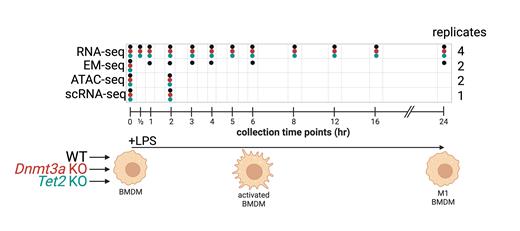Introduction
Clonal Hematopoiesis of Indeterminate Potential (CHIP) is a source of age-associated inflammation, caused by somatic mutations in bone marrow stem cells that promote clonal expansion. The functional impact of CHIP mutations on macrophages derived from these stem cells is linked to increased cardiovascular disease risk among other diseases. Interestingly, CHIP-associated mutations frequently occur in genes with opposing functions: DNMT3A and TET2, enzymes responsible for DNA methylation and demethylation, respectively. While it is known that DNMT3A KO and TET2 KO in macrophages lead to hyperinflammatory responses, the underlying mechanism remains poorly understood how opposing mutations lead to a similar phenotype.
Methods
To evaluate how DNMT3A and TET2 contribute to inflammatory responses in the context of CHIP, we exposed bone marrow derived macrophages from Dnmt3a KO, Tet2 KO, and C57BL/6 Vav1-Cre wild type (WT) control mice to 0.5 ng/mL of the inflammatory stimuli lipopolysaccharide (LPS). We then measured gene responses with RNA-seq replicates across 12 time points from 0 to 24 hours, paired with single cell RNA-seq (scRNA-seq), ATAC-seq, and 50x-coverage whole genome enzymatic methyl-seq (EM-seq) for multiple time points.
Results
Although the composition and kinetics of the LPS-induced expression program were similar in all genotypes, Dnmt3a KO and Tet2 KO had significantly greater changes in gene expression and chromatin accessibility by 2 hours compared to WT, particularly for a large subset of inflammatory response genes, like Il1b, Il6, Cxcl1, Tnfsf9, and Il23a. The promoter regions of the 278 genes significantly overexpressed (adjusted p < 0.05) for both KOs at 2 hours compared to WT were enriched with binding sites of the inflammatory pioneer factor AP-1 (p = 0.001).
Inflammatory signals were observed even before stimulation, suggesting altered DNA methylation in each KO predisposed cells to hyperinflammatory states. Bulk RNA-seq found the gene set ‘IFNA response’ from MSigDB Hallmarks collection to be most enriched at baseline in both KOs compared to WT (FDR < 0.0007). At baseline Dnmt3a KO and Tet2 KO had 1,566 and 441 over-expressed genes, respectively (adjusted p < 0.05). scRNA-seq similarly showed a baseline inflammatory population enriched with type 1 IFN response gene expression that contained more cells with measurable baseline expression of inflammatory genes for both KOs. ATAC-seq identified highly significant enrichment of AP-1 binding sites at baseline and at 2 hours in the 2,270 regions more accessible in Dnmt3a KO compared to WT (p = 1x10 -40), as well as the 2,148 regions less accessible in Tet2 KO compared to WT (p = 1x10 -41).
Although LPS stimulation did not lead to sites with altered CpG methylation using a genome-wide significance threshold, methylation globally differed between genotypes at baseline especially for promoter and enhancer regions, and this differential methylation directly explained some of the hyper-responsive chromatin accessibility and gene expression. For example, the promoter region of Cxcl1 for both KOs was significantly hypomethylated and more accessible at baseline, with these chromatin accessibility and associated expression differences becoming even larger at 2 hours of LPS stimulation. In general, DNA methylation and chromatin accessibility were rarely concordantly altered in both KOs at regions near genes with differential expression. For adjusted p-value < 0.05, Dnmt3a KO had 236,062 differentially hypomethylated CpG segments and 1,023 hypermethylated, while Tet2 KO had 7,488 hypomethylated and 4,482 hypermethylated segments.
Conclusions
Our integrative multi-omic analysis demonstrates that Dnmt3a and Tet2 modulate DNA methylation to limit inflammatory gene expression in healthy macrophages. We find loss of Dnmt3a or Tet2 activity in macrophages alters baseline DNA methylation at different regions, separately influencing the transcription factor binding landscape of AP-1, and inducing similar baseline over-expression of type 1 interferon response genes. Upon stimulation, these differences lead to higher inflammatory gene expression, possibly through more cooperation with transcription factors NF-κB and IRFs. Targeting AP-1 and type 1 interferon may be a therapeutic avenue for blocking the pathogenic role of CHIP for many inflammatory diseases of aging.
Disclosures
No relevant conflicts of interest to declare.


This feature is available to Subscribers Only
Sign In or Create an Account Close Modal